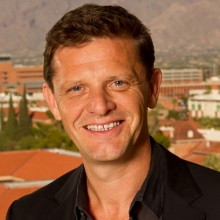CEE Seminar: Catchment Co-evolution - Useful Framework for Improving Predictions of Hydrological Change?

Professor & Agnese Haury Endowed Chair in Environment
Professor, Hydrology & Water Resources
University of Arizona
Abstract: The notion that landscape features have coevolved over time is well known in the Earth sciences. Hydrologists recently have called for a more rigorous connection between emerging spatial patterns of landscape features and the hydrological response of catchments, and have termed this concept catchment coevolution. In this presentation, we present a general framework of catchment coevolution that could improve predictions of hydrologic change. We first present empirical evidence of the interaction and feedback of landscape evolution and changes in hydrological response. From this review it is clear that the independent drivers of catchment coevolution are climate, geology and tectonics. We identify common currency that allows comparing the levels of activity of these independent drivers, such that, at least conceptually, we can quantify the rate of evolution or aging. Knowing the hydrologic age of a catchment by itself is not very meaningful without linking age to hydrologic response. Two avenues of investigation have been used to understand the relationship between (differences in) age and hydrological response: (i) one that is based on relating present landscape features to runoff processes that are hypothesized to be responsible for the current fingerprints in the landscape; and (ii) one that takes advantage of an experimental design known as space-for-time substitution. Both methods have yielded significant insights in the hydrologic response of landscapes with different histories. If we want to make accurate predictions of hydrologic change, we also will need to be able to predict how the catchment will further coevolve in association with changes in the activity levels of the drivers (e.g., climate). There is ample evidence in the literature that suggests that whole-system prediction of catchment coevolution is, at least in principle, plausible. With this imperative we outline a research agenda that implements the concepts of catchment coevolution for building a holistic framework toward improving predictions of hydrologic change. We will illustrate some of these concepts using data from the institutional experiment currently in progress at the Landscape Evolution Observatory at Biosphere 2.

Bio: Troch graduated from the University of Ghent (Belgium) in agricultural engineering (1985), and obtained an M.Sc. in control systems engineering (1989). He worked as a research and teaching assistant at the Laboratory of Hydrology and Water Management and the Seminar for Applied Mathematics. From January to August 1992, Troch visited the Water Resources Program of Princeton University and assisted E.F. Wood in developing remote-sensing applications in hydrological modeling. In 1993 he got his Ph.D. degree in hydrology; his thesis was titled "Conceptual Basinscale Runoff Process Models for Humid Catchments: Analysis, Synthesis and Applications." Troch was appointed assistant professor (1993) and associate professor (1996) in the Department of Forest and Water Management of the University of Ghent. In 1999, he moved to the Netherlands to become a full professor in hydrology and quantitative water management at Wageningen University. In November 2005, he joined the Department of Hydrology and Water Resources at UA. Troch was associate editor for water resources research from 1999 to 2005 and is a member of the editorial board of Advances in Water Resources.
His research aims at a better understanding of catchment-scale hydrological processes through advanced measurement, modeling and synthesis methods. His objectives are:
- Developing, testing and applying advanced observation methods for hydrological fluxes and states at a range of spatial and temporal scales
- Developing hillslope-to-catchment-scale hydrological models for water and solute transport
- Hydrological synthesis at the catchment scale with special attention to hydrological extremes
The motivation is to contribute to improved water resources management in the light of climate change and other human influences on the hydrological cycle.
Share
Download
Upcoming Events
-
MSE 298 Seminar: Catalyst Design For Clean Energy Technologies
-
MAE 298 SEMINAR: Biomechanics of Rotator Cuff
-
CBE 298 Seminar: Micro- and Nanofluidic Systems for Molecular Biosensing, Nanotoxicity, and Optogenetics
-
MSE Special Seminar: Architecting 3D Complex Materials for Sustainability
-
MSE Special Seminar: Decarbonizing Industries for a Climate-resilient Future - From Renewable Energy to Sustainable Material Recovery
